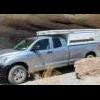
What do I need to know about solar
#1

Posted 30 September 2011 - 04:53 AM
So I ordered a 40 watt solar panel (~2.5amps), a 6 amp controller and 30 foot of 10 AWG cable (overkill). The panel is about two foot by two foot by 2 inches. Needless to say I am thinking of a movable unit, not something screwed to the top. I figure I can park in the shade move my solar panel out into the sun and let 'er rip. Maybe I can add another one later and boost up to 80 watts and 5 amps? Who knows.
I am thinking of attaching a back center leg so I can lean the it back into the sun and a very small wire to secure it to the local tree/post/rock/nasty dog.
So what is my reality check here? Do-able or forget it?
Thanks!
Roger
#2

Posted 30 September 2011 - 01:38 PM
There are pictures of folks with similar setups. (You probably saw them.)
I would use an outdoor extension cord for the leads. It would be much more durable and 14 gauge (seems to be most common) is not too expensive.
Go all hollywood and put a trolling motor connector/plug at the camper interface.
[Edit]
Oh yeah, and dogs tend to stick to shady spots...
#3

Posted 30 September 2011 - 06:26 PM
Voltage drop with a small gauge wire is be a problem if you use a long cable. You are working with lower voltages than normal house power (about 1/10 as much) so using 10 gauge cable for your cord isn't overkill. You can measure the voltage drop by reading the output from the panel at the connections and then at the end of the connecting cable. You want as little drop as possible to take advantage of the small size of your panel. Maximum output of panels is under ideal lab conditions, likely never obtained in the field. There will also be losses in the controller and connecting wire in the camper. It all adds up. Try it and see how it works, panel prices are coming down all the time and you can always add to or buy a larger panel if you think it's necessary. I use a 80 watt panel and it keeps up with my Engel fridge in the sunny southwest where I live. It won't recharge a 50% depleted battery AND run the fridge in a day but brings the battery up to about 75-80% in addition to running the fridge.
Dsrtrat
quote name='Roger' date='30 September 2011 - 05:53 AM' timestamp='1317358424' post='57040']
I think I've read every topic in the solar thread above. Running the worksheets I discovered I am not using that much battery at all, I just need a trickle, I use about 10-15 amps a day in the spring/summer. More in the winter, but I don't see the sun much in the winter so, no dice there. I figure, on a nice sunny spring/summer day I can get about, at least one, five hour day.
So I ordered a 40 watt solar panel (~2.5amps), a 6 amp controller and 30 foot of 10 AWG cable (overkill). The panel is about two foot by two foot by 2 inches. Needless to say I am thinking of a movable unit, not something screwed to the top. I figure I can park in the shade move my solar panel out into the sun and let 'er rip. Maybe I can add another one later and boost up to 80 watts and 5 amps? Who knows.
I am thinking of attaching a back center leg so I can lean the it back into the sun and a very small wire to secure it to the local tree/post/rock/nasty dog.
So what is my reality check here? Do-able or forget it?
Thanks!
Roger
[/quote]
#4

Posted 30 September 2011 - 06:35 PM
2022 F350 7.3L; family trailer at the moment and some aluminum stuck together to eventually form another truck camper
#5

Posted 30 September 2011 - 09:02 PM
Reducing loss is important. Pods8's numbers seem to be calculated at 12V. I think most solar panels put out about 17 volts?
using pods8's calcs and assuming 12V:
A 2.2% drop (.264V at 2.5 amps) means .66 watts.
A .9% drop (.108V at 2.5 amps) means .27 watts.
The loss in watts is the same no matter what the input voltage is. (resistance is fixed and we fixed amperage)
I thought looking at the numbers in terms of power might be helpful. If Pods8 used a different voltage then I'll be off a bit.
1ft distance and it won't matter.
If you are fixating on 2% loss and you will place it a football field away then you need 2 gauge.
In summary, 10 gauge is not necessarily overkill, and I would use a drop cord.
#6

Posted 30 September 2011 - 09:27 PM
2.2% drop at 18V isn't something I would personally worry that much about if the panel is getting good voltage output, that is where the "practical" part comes in. Heavier never hurts but no sense going lots heavier than needed if the costs and availability of supplies go up too.
2022 F350 7.3L; family trailer at the moment and some aluminum stuck together to eventually form another truck camper
#7

Posted 30 September 2011 - 10:30 PM
I used 18V for those numbers since it was closest to what a solar panel would be on the calculator I was using.
Ah, I poked my finger at a handy distance chart and tried to guess. Your method is much more accurate.
So, the new numbers are (in case someone is wondering):
2.2% drop = .396V * 2.5 amps = .99 watts
.9% drop = .162 * 2.5 amps = .405 watts
And I agree with your "practical" assessment.
Roger, I didn't do all the math available here. Some things to consider now that I've sucked myself deeper into the subject.
Your numbers (40 watts and 2.5 amps) equates to 16 volts.
If it really puts out 18 volts then the amperage is 2.222 amps.
These small differences matter because your situation is right on the edge.
If we assume you'll loose 20% of your power due to sun angle/line loss/conversion loss/ etc. (and again, I do not know what is typically) then you have 33 watts to put into your battery.
You said you need a 15 amp day. let's stick the voltage to 14.2V for battery charging (low end of absorption stage - constant voltage - and I don't know what your controller does). Your system can then supply 2.34 amps to the battery which is 6.41 hours of sunlight.
if you assume 33% power loss then it comes out to 7.89 hours. (27 watts)
Keep in mind that losses are cardinal and constant so a jump in panel size won't change the loss any but will increase the power supplied to the battery.
7.89 hours works for me here this time of year.
#8

Posted 01 October 2011 - 03:03 AM
Thanks for the help. I received my panel, controller and the wire. Whoops, wire should have been plural. Duh. Well it will be another week before I can plug it in, but that will give me some time to find a good place for the controller and to get all of the interior wiring squared away.
I know the panel is kinda small, but I really don't use that much of the battery so I think I got the right size. Good thing I bought the larger wire, I kinda see now why it is so important.
Thanks!
Roger
#9

Posted 01 October 2011 - 03:55 AM
So in your example above if you had 18V @ 2.22amps (40watts) going into the PWM controller and it's output was 14.2V you'd still only have 2.22amps (at 31.5watts) coming out assuming no efficiency loss in terms of amps in the controller (I believe the remaining 8.5watts are dissipated as heat in the controller).
2022 F350 7.3L; family trailer at the moment and some aluminum stuck together to eventually form another truck camper
#10

Posted 01 October 2011 - 05:12 AM
JohnF, However it wouldn't make any sense to spend the money on an MPPT controller for a 40watt panel so it's pretty save to assume we're taking PWM here.
**** right, no loss of energy, lost to heat...***
Yeah it is a PWM controller. Morning Star Sun Saver 6-12V to be exact.
Roger
0 user(s) are reading this topic
0 members, 0 guests, 0 anonymous users













